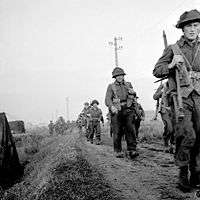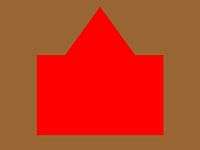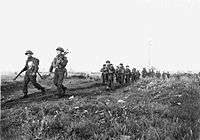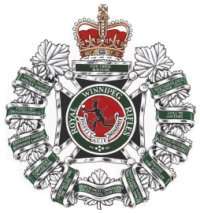Royal Winnipeg Rifles
| Royal Winnipeg Rifles | |
|---|---|
|
Cap badge of the Royal Winnipeg Rifles | |
| Active | 1883–present |
| Country | Canada |
| Branch | Primary Reserve |
| Type | Rifles |
| Part of | Royal Canadian Infantry Corps |
| Garrison/HQ |
Minto Armoury Winnipeg, Manitoba |
| Nickname(s) | Little Black Devils |
| Motto | "Hosti Acie Nominati" |
| March | Old Solomon Levi |
| Commanders | |
| Colonel-in-Chief | HRH the Prince of Wales |
| Abbreviation | R Wpg Rif |
The Royal Winnipeg Rifles (R Wpg Rif) are a Primary Reserve one-battalion infantry regiment of the Canadian Army. Nicknamed the "Little Black Devils", they are based at Minto Armouries in Winnipeg, Manitoba. The Royal Winnipeg Rifles are part of 3rd Canadian Division's 38 Canadian Brigade Group.
History

The 90th Winnipeg Battalion of Rifles were formed on 9 November 1883 under the command of Lieutenant Colonel William Nassau Kennedy. Within two years of formation, the 90th battalion served in the 1885 North-West Rebellion, fighting at Fish Creek and Batoche.[1] The regimental Latin motto is Hosti Acie Nominati, which means “named by the enemy in battle”. After the Battle of Fish Creek during the North-West Rebellion of 1885, a captured Métis asked, "The red coats we know, but who are those little black devils?", a reference to the fact that while infantry of the line wore red coats, the Winnipeg soldiers were clad in traditional rifle green. From that point on, the 90th Rifles (and later Royal Winnipeg Rifles) became informally nicknamed the "Little Black Devils".
Some former members of the 90th Rifles served in South Africa during the Boer War as members of other Canadian units, resulting in the award of the South Africa 1899-1900 battle honour.[2]

The regiment raised several battalions for the Canadian Expeditionary Force in the Great War, the most notable being the 8th Battalion (90th Winnipeg Rifles), CEF, which served in the 2nd Infantry Brigade, 1st Canadian Division. The Battalion saw some of the heaviest fighting in World War I, distinguishing itself at battles such as Ypres, the Somme, Vimy, Passchendaele, Amiens, Arras and Cambrai.[1]
Three members of the 8th battalion were awarded Canada's highest honour for gallantry in the face of the enemy, the Victoria Cross.[1]
In the 1920 reorganization of the Canadian Militia following the report of the Otter Committee, the regiment's former designation as 90th Regiment was dropped and became known as The Winnipeg Rifles. In 1935 the unit was awarded the prefix 'Royal' for its distinguished service to His Majesty, and the current designation of The Royal Winnipeg Rifles (R Wpg Rif) was adopted.[1]
In World War II the regiment landed in England in September 1940. As part of the 7th Infantry Brigade, 3rd Canadian Division, the Rifles were in the first wave of landings on D Day, 6 June 1944. The Royal Winnipeg Rifles fought throughout the Normandy campaign, fighting in famous battles such as Caen and the Falaise Gap. After helping liberate several of the Channel Ports, the Regiment fought to clear the Scheldt Estuary to allow the re-opening of the Antwerp harbour. After helping to liberate the Netherlands, the Regiment ended the war preparing to assault the northern German town of Aurich.[1]
Three battalions of the regiment served during the Second World War. The 1st Battalion served in the 3rd Canadian Infantry Division, the 2nd Battalion was a reserve unit that remained on part-time duty in Winnipeg, and a 3rd Battalion served in the Canadian Army Occupation Force.
The 1st Battalion were among the first Allied troops to land on the Normandy beaches on D-Day. They served throughout the Northwest Europe campaign, including the Battle of the Scheldt, the Rhineland, and the final battles across the Rhine, before returning to Canada in 1945. The 3rd Battalion was raised in 1945 and remained in Germany until 1946.
In 1950 the regiment helped the civil authority during the Winnipeg flood during Operation RED RAMP. During 1951-53, they provided men to the 1st Canadian Rifle Battalion for NATO duty with 27th Brigade Group in Germany. Members of the Regiment also served with other units during the Korean conflict. In 1955 the Winnipeg Light Infantry amalgamated with The Royal Winnipeg Rifles bringing together the histories and traditions of two military units with no change in designation.[1]
On 6 June 1964, a commemorative D Day monument was erected on the beaches at Courcelles-sur-Mer. In 1978 Prince Charles, The Prince of Wales, became the Colonel-in-Chief of the regiment. Subsequently, a contingent of Rifles attended the wedding of HRH Prince Charles to Lady Diana Spencer on 29 July 1983.[1]
In 1983 The Royal Winnipeg Rifles, celebrated a one hundred years of military service to Canada with numerous events and an official postage stamp.[1]
The regiment has recently contributed numerous soldiers to overseas deployments in the Balkans and to Canadian operations in Afghanistan.[1]
As of 2009, the Royal Winnipeg Rifles and the Queen's Own Cameron Highlanders (both stationed at Minto Armoury) have been merged into the Winnipeg Infantry Tactical Group (Wpg Inf Tac Grp, or WITG). Both infantry regiments still retain a large majority of their traditions but now have a mixed and fully cooperative chain of command with only one commanding officer (CO) for both units.
The Royal Winnipeg Rifles perpetuate the 91st "Winnipeg" Battalion of Light Infantry of 1885-1888 and the 8th, 10th, 27th, 44th, 61st, 90th, 101st, 144th, 190th, 203rd, 222nd and 226th Battalion(s), Canadian Expeditionary Force.
Lineage
Lineage of the Royal Winnipeg Rifles:[3]
| Lineage | |||||||||||||||||||||||||||||||||||||||||||||||||||||||||||||||||||||||||||||||||||||||||||||||||||||||||||||||||||||||||||||||||||||||||||||||||||||||||||||||||||||||||||||||||||||||||||||||||||||||||||||||||||||||||||||||||||||||||||||||||||||||||||||||||||||||||||||||||||||||||||||||||||||||||||||||||||||||||||||||||||||||||||||||||||||||||||||||||||||||||||||||||||||||||||||||||||||||||||||||||||||||||||||||||||||||||||||||||||||||||||||||||||||||||||||||||||||||||||||||||||||||||||||||||||||||||||||||||||||||||||||||||||||||||||||||||||||||||||||||||||||||||||||||||||||||||||||||||||||||||||||||||||||||||||||||||||||||||||||||||||||||||||||||||||||||||||||||||||||||||||||||||||||||||||||||||||||||||||||||||||||||||||||||||||||||||||||||||||||||||||||||||||||||||||||||||||||||||||||||||||||||||||||||||||||||||||||||||||||||||||||||||||||||||||||||||||||||||||||||||||||||||||||||||||||||||||||||||||||||||||||||||||||||||||||||||||||||||||||||||||||||||||||||||||||||||||||||||||||||
|---|---|---|---|---|---|---|---|---|---|---|---|---|---|---|---|---|---|---|---|---|---|---|---|---|---|---|---|---|---|---|---|---|---|---|---|---|---|---|---|---|---|---|---|---|---|---|---|---|---|---|---|---|---|---|---|---|---|---|---|---|---|---|---|---|---|---|---|---|---|---|---|---|---|---|---|---|---|---|---|---|---|---|---|---|---|---|---|---|---|---|---|---|---|---|---|---|---|---|---|---|---|---|---|---|---|---|---|---|---|---|---|---|---|---|---|---|---|---|---|---|---|---|---|---|---|---|---|---|---|---|---|---|---|---|---|---|---|---|---|---|---|---|---|---|---|---|---|---|---|---|---|---|---|---|---|---|---|---|---|---|---|---|---|---|---|---|---|---|---|---|---|---|---|---|---|---|---|---|---|---|---|---|---|---|---|---|---|---|---|---|---|---|---|---|---|---|---|---|---|---|---|---|---|---|---|---|---|---|---|---|---|---|---|---|---|---|---|---|---|---|---|---|---|---|---|---|---|---|---|---|---|---|---|---|---|---|---|---|---|---|---|---|---|---|---|---|---|---|---|---|---|---|---|---|---|---|---|---|---|---|---|---|---|---|---|---|---|---|---|---|---|---|---|---|---|---|---|---|---|---|---|---|---|---|---|---|---|---|---|---|---|---|---|---|---|---|---|---|---|---|---|---|---|---|---|---|---|---|---|---|---|---|---|---|---|---|---|---|---|---|---|---|---|---|---|---|---|---|---|---|---|---|---|---|---|---|---|---|---|---|---|---|---|---|---|---|---|---|---|---|---|---|---|---|---|---|---|---|---|---|---|---|---|---|---|---|---|---|---|---|---|---|---|---|---|---|---|---|---|---|---|---|---|---|---|---|---|---|---|---|---|---|---|---|---|---|---|---|---|---|---|---|---|---|---|---|---|---|---|---|---|---|---|---|---|---|---|---|---|---|---|---|---|---|---|---|---|---|---|---|---|---|---|---|---|---|---|---|---|---|---|---|---|---|---|---|---|---|---|---|---|---|---|---|---|---|---|---|---|---|---|---|---|---|---|---|---|---|---|---|---|---|---|---|---|---|---|---|---|---|---|---|---|---|---|---|---|---|---|---|---|---|---|---|---|---|---|---|---|---|---|---|---|---|---|---|---|---|---|---|---|---|---|---|---|---|---|---|---|---|---|---|---|---|---|---|---|---|---|---|---|---|---|---|---|---|---|---|---|---|---|---|---|---|---|---|---|---|---|---|---|---|---|---|---|---|---|---|---|---|---|---|---|---|---|---|---|---|---|---|---|---|---|---|---|---|---|---|---|---|---|---|---|---|---|---|---|---|---|---|---|---|---|---|---|---|---|---|---|---|---|---|---|---|---|---|---|---|---|---|---|---|---|---|---|---|---|---|---|---|---|---|---|---|---|---|---|---|---|---|---|---|---|---|---|---|---|---|---|---|---|---|---|---|---|---|---|---|---|---|---|---|---|---|---|---|---|---|---|---|---|---|---|---|---|---|---|---|---|---|---|---|---|---|---|---|---|---|---|---|---|---|---|---|---|---|---|---|---|---|---|---|---|---|---|---|---|---|---|---|---|---|---|---|---|---|---|---|---|---|---|---|---|---|---|---|---|---|---|---|---|---|---|---|---|---|---|---|---|---|---|---|---|---|---|---|---|---|---|---|---|---|---|---|---|---|---|---|---|---|---|---|---|---|---|---|---|---|---|---|---|---|---|---|---|---|---|---|---|---|---|---|---|---|---|---|---|---|---|---|---|---|---|---|---|---|---|---|---|---|---|---|---|---|---|---|---|---|---|---|---|---|---|---|---|---|---|---|---|---|---|---|---|---|---|---|---|---|---|---|---|---|---|---|---|---|---|---|---|---|---|---|---|---|---|---|---|---|---|---|---|---|---|---|---|---|---|---|---|---|---|---|---|---|---|---|---|---|---|---|---|---|---|---|---|---|---|---|---|---|---|---|---|---|---|---|---|---|---|---|---|---|---|---|---|---|---|---|---|---|---|---|---|---|---|---|---|---|---|---|---|---|---|---|---|---|---|---|---|---|---|---|---|---|---|---|---|---|---|---|---|---|---|---|---|---|---|---|---|---|---|---|---|---|---|---|---|---|---|---|---|---|---|---|---|---|---|---|---|---|---|---|---|---|---|---|---|---|---|---|---|---|---|---|---|---|---|---|---|---|---|---|---|---|---|---|---|---|---|---|---|---|---|---|---|---|---|---|---|---|---|---|---|---|---|---|---|---|---|
|
| ||||||||||||||||||||||||||||||||||||||||||||||||||||||||||||||||||||||||||||||||||||||||||||||||||||||||||||||||||||||||||||||||||||||||||||||||||||||||||||||||||||||||||||||||||||||||||||||||||||||||||||||||||||||||||||||||||||||||||||||||||||||||||||||||||||||||||||||||||||||||||||||||||||||||||||||||||||||||||||||||||||||||||||||||||||||||||||||||||||||||||||||||||||||||||||||||||||||||||||||||||||||||||||||||||||||||||||||||||||||||||||||||||||||||||||||||||||||||||||||||||||||||||||||||||||||||||||||||||||||||||||||||||||||||||||||||||||||||||||||||||||||||||||||||||||||||||||||||||||||||||||||||||||||||||||||||||||||||||||||||||||||||||||||||||||||||||||||||||||||||||||||||||||||||||||||||||||||||||||||||||||||||||||||||||||||||||||||||||||||||||||||||||||||||||||||||||||||||||||||||||||||||||||||||||||||||||||||||||||||||||||||||||||||||||||||||||||||||||||||||||||||||||||||||||||||||||||||||||||||||||||||||||||||||||||||||||||||||||||||||||||||||||||||||||||||||||||||||||||||
Traditions

The Royal Winnipeg Rifles follow the traditions of rifle regiments throughout Great Britain and the Commonwealth. Thus they do not have a stand of regimental colours and march "at the double": the traditional rate of 140 paces a minute. Rifles are usually carried "at the trail". Battle honours are borne on the cap badge and drums. The Royal Winnipeg Rifles badge depicts a devil carrying a trident and in imitation of a rifleman's role on the battlefield, he is depicted as running. As is also traditional in rifle regiments for reasons of concealment, buttons and badges are "blackened" or darkened and are not polished.
The formal rank designation of a trained Private (one chevron) of the Royal Winnipeg Rifles is "Rifleman".
The regimental band's drums are emblazoned with the unit's battle honours. The regimental Pioneers form the escort to the colours when on parade. The Pioneers wear leather aprons and carry special tools and weapons: axes or hatchets, picks, and halberds. Along with the Pioneers there are also Skirmishers who wear the traditional uniform of a 90th Battalion rifleman circa 1885. The Skirmishers often appear in ceremonies and memorials such as Remembrance Day and events.
The regimental march of the Royal Winnipeg Rifles is "Pork, Beans and Hard Tack (Old Solomon Levi)" and the double quick march is "The Keel Row".
Recognition
On 10 November 1983 Canada Post issued 'The Royal Winnipeg Rifles, The Royal Canadian Dragoons as part of the Canadian Forces, Regiments, 1883-1983 series. The stamps were designed by Ralph Tibbles, based on a painting by William Southern. The 32¢ stamps are perforated 13.5 x 13 and were printed by Canadian Bank Note Company, Limited.[4]
Battle honours
In the list below, battle honours in small capitals were awarded for participation in large operations and campaigns, while those in lowercase indicate honours granted for more specific battles. The battle honours in bold type are emblazoned on the cap badge.
- North West Rebellion
- South African War
- First World War
- Ypres, 1915, '17
- Gravenstafel
- St. Julien
- Festubert, 1915
- Mount Sorrel
- Somme, 1916, '18
- Flers–Courcelette
- Thiepval
- Ancre Heights
- Ancre, 1916
- Arras, 1917, '18
- Vimy, 1917
- Arleux
- Hill 70
- Passchendaele
- Amiens
- Scarpe, 1917, '18
- Drocourt–Quéant
- Hindenburg Line
- Canal du Nord
- Cambrai, 1918
- Valenciennes
- France and Flanders, 1915–18
- Second World War
- Normandy Landing
- Putot-en-Bessin
- Caen
- Carpiquet
- The Orne
- Bourguébus Ridge
- Falaise
- The Laison
- The Seine, 1944
- Calais, 1944
- The Scheldt
- Leopold Canal
- Breskens Pocket
- The Rhineland
- Waal Flats
- Moyland Wood
- The Rhine
- Emmerich–Hoch Elten
- Deventer
- North-West Europe, 1944–1945
- War in Afghanistan
- Afghanistan[5]
Alliances
Royal Canadian Army Cadets
The RWR has an army cadet corps of the same name, Royal Winnipeg Rifles Cadet Corps, formed in 1947. The cadet corps is based at Minto Armoury in Winnipeg.
Victoria Cross holders
- Alexander Picton Brereton
- Frederick George Coppins
- Frederick William Hall
- Harry W. Brown
- Arthur George Knight
- Robert Grierson Combe
- James Peter Robertson
Royal Winnipeg Rifles Regimental Museum
| Location | Minto Armoury, 969 St. Matthews Avenue, Winnipeg, Manitoba, Canada |
|---|---|
| Type | Military Museum |
The museum preserves the history of the regiment through the collection, preservation and display of military artifacts, pictures, books, documents etc., which pertain to the regiment and commencing with the Red River Expedition of 1870 to the present. The museum provides the battalion with a training facility for teaching regimental history. The museum stimulates and fosters within the general public, an interest and sense of pride in the regiment, its activities and accomplishments.[6] The museum is affiliated with: CMA, CHIN, OMMC and Virtual Museum of Canada.
Media
- Named by the Enemy: A History of the Royal Winnipeg Rifles by Brian A. Reid (Jan 31 2010)
- Little Black Devils: A History of the Royal Winnipeg Rifles by Bruce; Wells, Eric Tascona (1983)
See also
- Organization of Military Museums of Canada
- The Canadian Crown and the Canadian Forces
- 38 Canadian Brigade Group Website (ref: Royal Winnipeg Rifles)
Order of precedence
| Preceded by The Cameron Highlanders of Ottawa (Duke of Edinburgh's Own) |
The Royal Winnipeg Rifles | Succeeded by The Essex and Kent Scottish |
References
- 1 2 3 4 5 6 7 8 9 "Royal Winnipeg Rifles". Army.gc.ca. 2012-07-20. Retrieved 2012-07-26.
- ↑ "38 Canadian Brigade Group website".
- ↑ "The Royal Winnipeg Rifles". Official Lineages Volume 3, Part 2: Infantry Regiments. Directorate of History and Heritage. Retrieved 19 October 2012.
- ↑ Canada Post stamp
- ↑ "South-West Asia Theatre Honours". Office of the Prime Minister of Canada. Retrieved 11 May 2014.
- ↑ A-AD-266-000/AG-001 Canadian Forces Museums –Operations and Administration 2002-04-03
External links
- The Royal Winnipeg Rifles site (official)
- The Royal Winnipeg Rifles site (unofficial)
- Juno Beach: The Winnipeg Rifles on D-Day
- The Royal Winnipeg Rifles (Army.ca)
| ||||||||||||||||||||||||||||||||||||||
| Wikimedia Commons has media related to Royal Winnipeg Rifles. |
Coordinates: 49°53′27″N 97°10′44″W / 49.8907°N 97.1788°W
